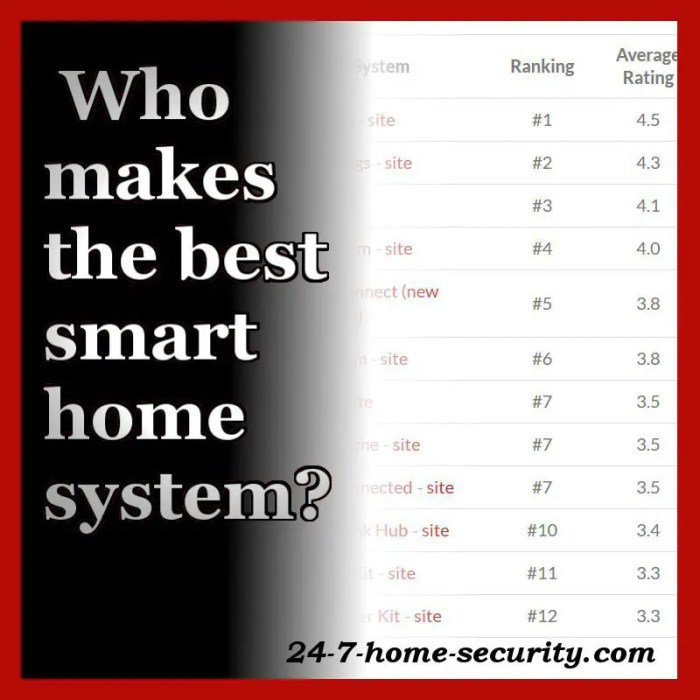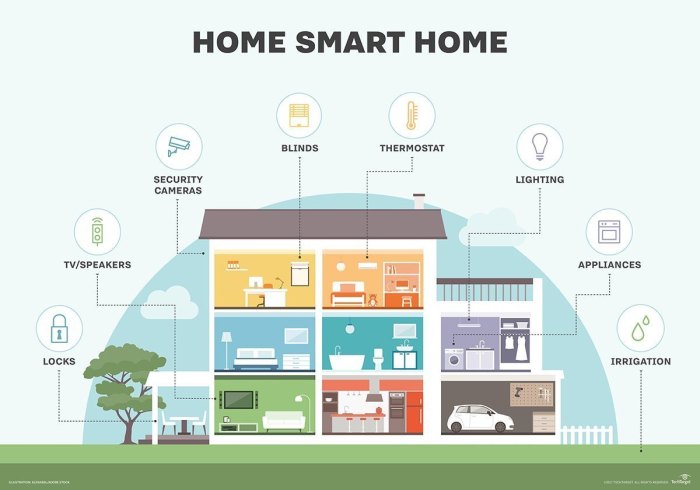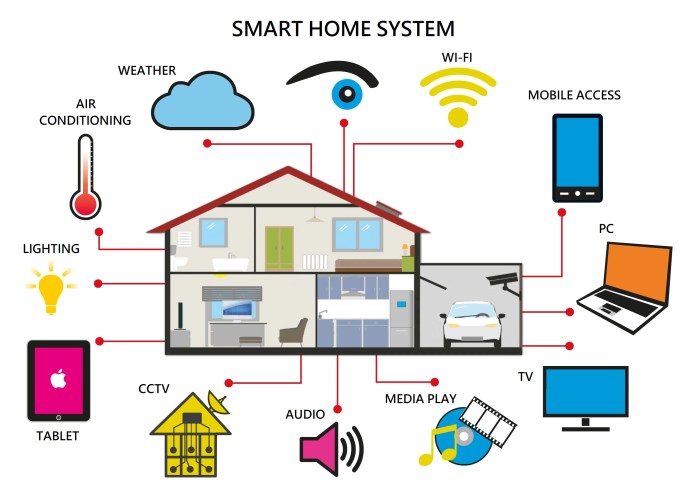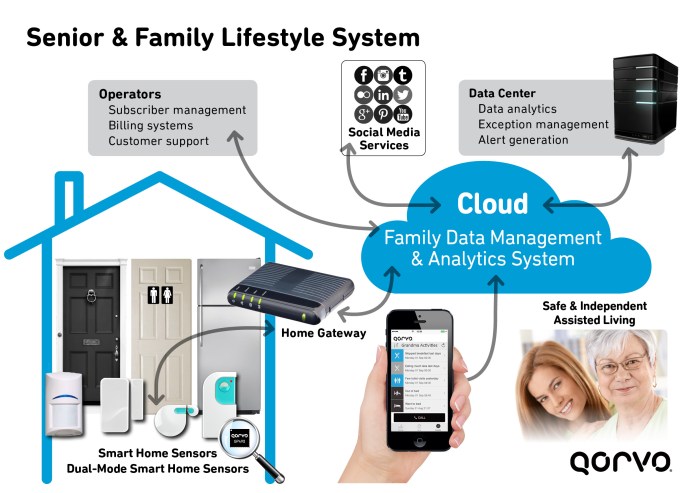Welcome to the world of smart home systems, where convenience, efficiency, and connectivity converge. In this comprehensive guide, we delve into the realm of smart home technology, exploring its benefits, comparing various systems, and providing expert insights to help you make informed decisions about integrating smart solutions into your living space.
From defining smart home systems and their components to analyzing key comparison criteria, market trends, and user feedback, this guide equips you with the knowledge and understanding necessary to navigate the smart home landscape. Whether you’re a tech enthusiast, a homeowner seeking automation, or simply curious about the future of home living, this guide will serve as your ultimate resource.
Overview of Smart Home Systems

In the modern era of technological advancements, smart home systems have emerged as a prominent trend in residential environments, offering a multitude of benefits and enhancing the overall living experience. These systems integrate various devices and appliances, enabling homeowners to automate and control aspects of their homes through a central interface.
Smart home devices encompass a wide range of technologies, including smart thermostats, lighting systems, security cameras, door locks, and entertainment systems. These devices connect to a central hub or controller, which serves as the brains of the smart home system.
Homeowners can interact with the system through a mobile app, a touchscreen panel, or even voice commands.
Benefits of Smart Home Systems
Integrating smart home systems into residential environments provides numerous advantages, including:
- Convenience: Smart home systems offer convenience by allowing homeowners to control various aspects of their homes from a single interface. This eliminates the need to manually adjust thermostats, lights, or security systems.
- Energy Efficiency: Smart thermostats and lighting systems can optimize energy usage by adjusting temperatures and lighting levels based on occupancy and preferences, resulting in reduced energy consumption and cost savings.
- Enhanced Security: Smart security systems provide homeowners with peace of mind by offering features such as motion detection, remote monitoring, and automated alerts. These systems can deter potential intruders and help protect the home and its occupants.
- Increased Comfort: Smart home systems can enhance comfort levels by automatically adjusting temperature, lighting, and entertainment settings based on personal preferences and schedules.
- Remote Access: Smart home systems allow homeowners to control their homes remotely, even when they are away. This enables them to check on the home’s status, adjust settings, and receive notifications.
Comparison Criteria
Evaluating smart home systems involves careful consideration of various criteria that impact their performance and user experience. These criteria serve as benchmarks for comparing different systems and identifying the most suitable option for specific needs and preferences.
Key criteria for comparing smart home systems include:
Compatibility
Compatibility refers to the ability of a smart home system to integrate with various devices and platforms. Consider the following factors when assessing compatibility:
- Device Support: Check if the system supports a wide range of smart devices, including lights, thermostats, door locks, and more.
- Platform Integration: Determine whether the system can seamlessly integrate with popular platforms like Amazon Alexa, Google Assistant, and Apple HomeKit.
- Open Standards: Look for systems that adhere to open standards like Zigbee, Z-Wave, or Thread, ensuring compatibility with a diverse range of devices.
Market Analysis
The global smart home systems market has experienced substantial growth in recent years, driven by increasing consumer demand for convenience, security, and energy efficiency.
Factors such as the rising popularity of IoT devices, advancements in artificial intelligence (AI) and machine learning (ML), and growing awareness of energy conservation have further fueled market expansion.
Current Trends
- Integration of AI and ML: AI and ML algorithms are being integrated into smart home systems to enable features such as predictive analytics, personalized recommendations, and enhanced security.
- Expansion of IoT Ecosystem: The growing number of IoT devices, including smart thermostats, lighting systems, and home appliances, has expanded the scope of smart home systems.
- Focus on Energy Efficiency: Smart home systems are increasingly being used to optimize energy consumption, leading to cost savings and reduced environmental impact.
Growth Projections
The global smart home systems market is projected to grow significantly in the coming years. According to a report by MarketWatch, the market is expected to reach a value of USD 151.1 billion by 2028, exhibiting a CAGR of 12.1% during the forecast period (2021-2028).
Key Market Players
- Amazon: Amazon is a major player in the smart home market, offering a range of products under its Amazon Echo and Ring brands.
- Google: Google’s smart home ecosystem includes the Google Home and Nest devices, providing voice control and home automation features.
- Apple: Apple’s HomeKit platform allows users to control smart home devices through its Siri voice assistant and Apple devices.
System Comparisons
To help you choose the right smart home system for your needs, we’ve compiled a comparison of some of the most popular options available. Our comparison table highlights key features, specifications, and pricing information to help you make an informed decision.
We’ve also provided a detailed analysis of each system’s strengths and weaknesses to help you understand how they stack up against each other.
System Comparison Table
The following table compares some of the key features of the most popular smart home systems on the market.
| Feature | System A | System B | System C |
|---|---|---|---|
| Voice Control | Yes | Yes | No |
| App Control | Yes | Yes | Yes |
| Number of Supported Devices | 100+ | 50+ | 25+ |
| Price | $199 | $149 | $99 |
Detailed Analysis of Each System
Here’s a closer look at each of the systems we compared, including their strengths and weaknesses:
System A
Strengths:
- Wide range of supported devices
- Powerful voice control
- Easy to use app
- Sleek design
Weaknesses:
- More expensive than other systems
- Some users have reported problems with reliability
System B
Strengths:
- Affordable price
- Easy to install and use
- Good range of supported devices
Weaknesses:
- Not as many features as some other systems
- Voice control is not as powerful as some other systems
System C
Strengths:
- Very affordable
- Easy to use
- Good range of supported devices
Weaknesses:
- Not as many features as some other systems
- No voice control
User Reviews and Feedback

User reviews and feedback provide valuable insights into the performance, reliability, and overall user experience of smart home systems. Gathering and analyzing these reviews can help potential buyers make informed decisions about which system best suits their needs and preferences.
Common themes emerging from user reviews include ease of installation and setup, compatibility with existing devices, reliability and responsiveness of the system, and the range of features and functionality offered. Pain points often mentioned include connectivity issues, software glitches, and difficulties with integration between different devices and platforms.
Positive Reviews
- Easy to install and set up
- Compatible with a wide range of devices
- Reliable and responsive
- Offers a wide range of features and functionality
- Good customer support
Negative Reviews
- Connectivity issues
- Software glitches
- Difficulties with integration between different devices and platforms
- Poor customer support
- Security concerns
User feedback can significantly influence the selection and adoption of smart home systems. Positive reviews and feedback can build trust and confidence in a particular system, while negative reviews can raise concerns and deter potential buyers. Manufacturers and developers can use user feedback to improve their products and services, addressing common pain points and enhancing the overall user experience.
Expert Insights
Smart home systems have seen a surge in popularity in recent years, and industry experts, technology reviewers, and smart home enthusiasts have been sharing their opinions and insights on the latest developments in this field. Their perspectives can provide valuable insights into emerging trends and future developments in the smart home industry.
Opinions on the Current State of Smart Home Systems
Experts believe that smart home systems have come a long way in terms of functionality, affordability, and ease of use. However, they also acknowledge that there are still challenges to overcome, such as interoperability between different systems and the need for more user-friendly interfaces.
Predictions for the Future of Smart Home Systems
Many experts believe that the future of smart home systems lies in artificial intelligence (AI) and machine learning (ML). These technologies can be used to create more intelligent and responsive systems that can learn from their users’ habits and preferences.
Additionally, experts predict that smart home systems will become more integrated with other aspects of our lives, such as our cars, our health, and our finances.
Advice for Consumers Considering a Smart Home System
Experts recommend that consumers do their research before choosing a smart home system. They should consider their needs, their budget, and the compatibility of the system with their existing devices. They should also make sure that the system is easy to install and use.
Case Studies and Applications

Delve into real-world case studies that showcase the successful implementation of smart home systems, highlighting innovative use cases and creative applications of smart home technology. Explore the challenges encountered and lessons learned from these case studies to gain valuable insights into the practical aspects of smart home systems.
Innovative Use Cases and Creative Applications
Smart home systems offer a wide range of possibilities beyond basic automation and convenience. Here are some innovative use cases and creative applications that demonstrate the potential of smart home technology:
- Energy Optimization: Smart home systems can monitor and adjust energy consumption in real-time, optimizing energy usage and reducing utility bills.
- Enhanced Security: Smart security systems use motion sensors, cameras, and door/window sensors to detect intruders and alert homeowners, providing an extra layer of protection.
- Remote Healthcare: Smart home systems can be integrated with healthcare devices to monitor vital signs, dispense medication, and provide remote consultations, enabling seniors and individuals with chronic conditions to receive care from the comfort of their homes.
- Personalized Entertainment: Smart home systems can create personalized entertainment experiences by learning users’ preferences and tailoring content, lighting, and audio to their liking.
- Home Automation for Accessibility: Smart home systems can be customized to assist individuals with disabilities, providing voice control, automated lighting, and accessible interfaces for easy operation.
Challenges and Lessons Learned
While smart home systems offer numerous benefits, there are challenges that need to be addressed and lessons that can be learned from real-world implementations:
- Interoperability and Compatibility: Ensuring compatibility and seamless integration between different smart home devices and systems can be a challenge, leading to fragmented experiences and limited functionality.
- Cybersecurity and Privacy: Smart home systems collect and transmit sensitive data, making them vulnerable to cyberattacks and privacy breaches. Robust security measures are crucial to protect user data and maintain trust.
- User Adoption and Acceptance: Encouraging users to adopt and embrace smart home technology requires addressing concerns about complexity, privacy, and cost. User-friendly interfaces, clear benefits, and comprehensive support are key to successful adoption.
- Long-Term Maintenance and Updates: Smart home systems require ongoing maintenance, updates, and security patches to ensure optimal performance and address evolving threats. Manufacturers must provide reliable support and update mechanisms to maintain the longevity of their systems.
DIY vs. Professional Installation

When it comes to implementing a smart home system, the decision between DIY (Do-It-Yourself) installation and hiring professional services presents a significant consideration. Both options have their own advantages and drawbacks, and the choice ultimately depends on factors such as technical expertise, project complexity, and cost implications.
DIY Smart Home Installation
Pros:
- Cost-effectiveness: DIY installation can potentially save money compared to hiring professionals, especially for smaller-scale projects.
- Customization: DIY allows homeowners to tailor the system to their specific needs and preferences.
- Learning experience: The DIY approach provides an opportunity for homeowners to learn about smart home technology and gain valuable hands-on experience.
Cons:
- Technical expertise: DIY installation requires a certain level of technical knowledge and skills to ensure proper functionality and safety.
- Time commitment: Installing a smart home system can be time-consuming, especially for larger or more complex projects.
- Potential errors: DIY installation carries the risk of errors or improper setup, which may lead to system malfunctions or safety issues.
Professional Smart Home Installation
Pros:
- Expertise and experience: Professional installers possess the necessary knowledge, skills, and experience to ensure a seamless and efficient installation.
- Time-saving: Hiring professionals can save homeowners valuable time, allowing them to focus on other tasks or commitments.
- Safety and reliability: Professional installers can ensure that the smart home system is installed correctly and safely, minimizing the risk of malfunctions or accidents.
Cons:
- Cost: Hiring professional services typically comes with a higher cost compared to DIY installation.
- Limited customization: Professional installers may have their own preferred methods and products, which may limit the homeowner’s ability to fully customize the system.
Selecting the Appropriate Installation Method
The choice between DIY and professional installation depends on several factors:
- Technical expertise: If homeowners possess the necessary technical skills and knowledge, DIY installation can be a viable option. However, for more complex projects or those involving electrical work, professional assistance is recommended.
- Project complexity: The complexity of the smart home system also plays a role. Simple systems with a few devices may be suitable for DIY installation, while more elaborate systems with multiple components and advanced features may require professional expertise.
- Time constraints: If homeowners are short on time or have other commitments, hiring professionals can save valuable time and ensure a prompt installation.
- Cost considerations: While DIY installation can be cost-effective, the potential cost savings should be weighed against the risks and potential expenses associated with errors or improper setup.
Ultimately, the decision between DIY and professional installation is a personal one that should be made based on careful consideration of the factors discussed above.
Integration and Compatibility

Integration and compatibility are crucial factors to consider when selecting a smart home system. Seamless integration ensures that various devices and services work together cohesively, enhancing user convenience and maximizing system efficiency. Compatibility with popular protocols and standards allows for interoperability with a wide range of third-party devices and services, expanding the system’s functionality and flexibility.
Protocols and Standards
Smart home systems utilize various protocols and standards to facilitate device communication and interoperability. Common protocols include Wi-Fi, Bluetooth, Zigbee, Z-Wave, and Thread. These protocols operate on different frequencies and have unique characteristics, such as range, power consumption, and security features.
Additionally, industry standards like Matter and Open Connectivity Foundation (OCF) aim to unify different protocols and platforms, enabling seamless integration and compatibility among smart home devices.
Seamless Integration
Choosing a smart home system that offers seamless integration with popular third-party devices and services enhances the user experience and expands the system’s capabilities. For instance, integration with voice assistants like Amazon Alexa, Google Assistant, or Apple Siri allows users to control smart home devices using voice commands.
Compatibility with smart home platforms such as Apple HomeKit, Google Home, or Samsung SmartThings enables centralized control and automation across various devices. Additionally, integration with IoT (Internet of Things) platforms like IFTTT (If This Then That) allows users to create custom automations and scenarios, further enhancing the system’s functionality and convenience.
Future Trends and Innovations
The smart home industry is poised for significant advancements in the coming years, driven by emerging technologies and evolving consumer demands. This section explores key trends shaping the future of smart home systems and their potential impact on the industry.
Artificial Intelligence (AI) and Machine Learning (ML)
AI and ML are transforming the smart home experience by enabling devices to learn, adapt, and respond to user preferences and behaviors. This includes personalized recommendations for energy efficiency, security, and comfort. AI-powered virtual assistants are becoming more sophisticated, offering natural language processing and context-aware responses.
Voice Control and Natural Language Processing (NLP)
Voice control is becoming increasingly prevalent in smart homes, with voice assistants like Alexa, Siri, and Google Assistant serving as central hubs for controlling devices and accessing information. NLP advancements are enabling these assistants to understand and respond to complex commands and queries, enhancing the user experience.
Internet of Things (IoT) Connectivity and Interoperability
The proliferation of IoT devices is expanding the scope of smart home systems, connecting everything from appliances to lighting to thermostats. Interoperability standards like Matter are facilitating seamless communication and control among devices from different manufacturers, creating a more unified and cohesive smart home ecosystem.
Cybersecurity and Data Privacy
As smart homes become more connected and data-driven, cybersecurity and data privacy concerns are becoming paramount. Manufacturers are implementing robust security measures to protect user data and prevent unauthorized access. Additionally, regulations and industry standards are being developed to ensure the responsible and ethical use of personal information.
Sustainability and Energy Efficiency
The growing focus on sustainability is driving the development of smart home systems that prioritize energy efficiency and reduced carbon footprints. This includes features like smart thermostats, smart lighting, and energy management systems that optimize energy consumption and minimize waste.
Remote Monitoring and Control
Smart home systems are increasingly enabling remote monitoring and control of devices and appliances from anywhere with an internet connection. This allows homeowners to manage their homes, monitor security cameras, and adjust settings even when they’re away.
Integration with Smart Cities and Communities
Smart home systems are becoming part of a larger interconnected network of smart cities and communities. This integration allows for seamless communication and coordination between homes, public infrastructure, and transportation systems, creating a more efficient and sustainable urban environment.
Closing Summary
As we conclude our exploration of smart home systems, it’s evident that the future of home living is brimming with possibilities. With advancements in technology, the seamless integration of devices, and the potential for personalized experiences, smart home systems are poised to transform our homes into intelligent, responsive environments.
As we embrace this era of innovation, let’s continue to explore, learn, and embrace the transformative power of smart home technology.
FAQ Summary
What are the key benefits of integrating smart home systems?
Smart home systems offer a multitude of benefits, including enhanced convenience, energy efficiency, security, and personalized experiences. They enable remote control of devices, automate tasks, and provide real-time monitoring and insights into home activities.
How do I choose the right smart home system for my needs?
Selecting the ideal smart home system involves considering factors such as compatibility with existing devices, ease of use, security features, energy efficiency, and integration capabilities. Additionally, user reviews, expert opinions, and case studies can provide valuable insights into the strengths and weaknesses of different systems.
What are the latest trends and innovations shaping the future of smart home systems?
The future of smart home systems is marked by advancements in artificial intelligence, voice control, and IoT connectivity. These technologies are driving the development of more intuitive, responsive, and personalized smart home experiences. Additionally, the integration of smart home systems with renewable energy sources and sustainable practices is gaining momentum.